The Huawei Mate 9 Review
by Matt Humrick on January 27, 2017 7:00 AM ESTDisplay
The Mate 9 still uses an FHD (1920x1080) IPS LCD like the Mate 8, but this is an entirely new panel with a different backlight assembly and a small reduction in screen size from 6 inches to 5.9 inches. This is more than just a rounding error: The Mate 9’s screen is definitely smaller, although it’s difficult to notice unless the two phones are sitting side by side. Pixel density increases to 373ppi, up from the Mate 8’s 368ppi, but again this is not really noticeable. While most flagship phones are now using QHD (2560x1440) panels, especially for AMOLED, FHD is still adequate for LCD panels up to around 6 inches due to its greater sub-pixel density relative to PenTile AMOLED panels. There is some loss of sharpness at this size, however. With the Mate 9, it’s possible to see a hint of aliasing on curved edges when specifically looking for it, but this is imperceptible during normal use. The Mate 9’s screen is still very sharp.
Even with a high-quality panel, proper calibration is still necessary, something Huawei has struggled with in the past. Its use of wide-gamut panels and unbalanced RGB settings, which lead to an overly cool white point and screens with an obvious blue tint, hurt color accuracy and negatively impact the user experience. To see if the Mate 9 breaks this trend, we’ll use an X-Rite i1Pro 2 spectrophotometer for color measurements and an i1Display Pro colorimeter for luminance measurements.
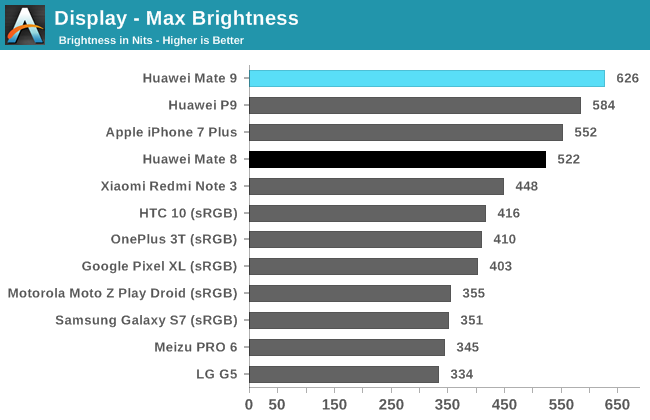
The Mate 9 reaches an impressive 626 nits at peak brightness, about 100 nits more than the Mate 8 and about the same as the iPhone 7 Plus, which hit 618 nits when using its auto-brightness boost (the value in the chart above is for manual mode). It’s even higher than Huawei’s P9 that uses a backlight with 20 LEDs (versus the usual 16 LEDs for a 5-inch class display) to increase peak brightness. And because the Mate 9 does not have an overdrive feature, this peak brightness is available in both manual and auto-brightness modes. Outdoor visibility is quite good, and the display goes down to 4 nits at its lowest setting, making it suitable for use in a dark room.

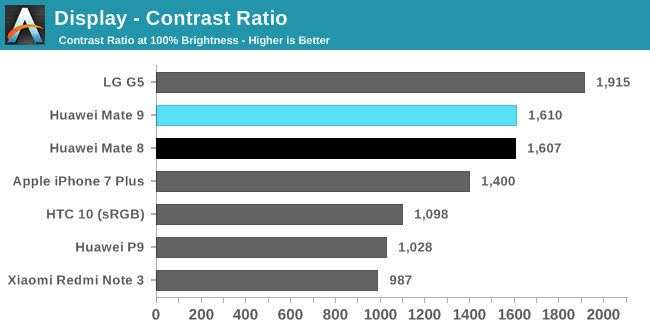
Black level and contrast ratio are measured at maximum brightness, which makes direct black level comparisons more difficult because a display’s black level increases with brightness; however, after normalizing for this effect, the Mate 9’s black level is among the best we’ve tested—equal to the Mate 8 and LG G5, a little better than the iPhone 7 Plus, and noticeably better than the HTC 10. Based on these results, it’s safe to say that the Mate 9’s display uses photo-aligned crystals to improve black level and contrast ratio.
The phones with OLED panels are not shown in these charts because they are able to achieve a black level of zero and a mathematically infinite contrast ratio by being able to completely turn off individual pixels.
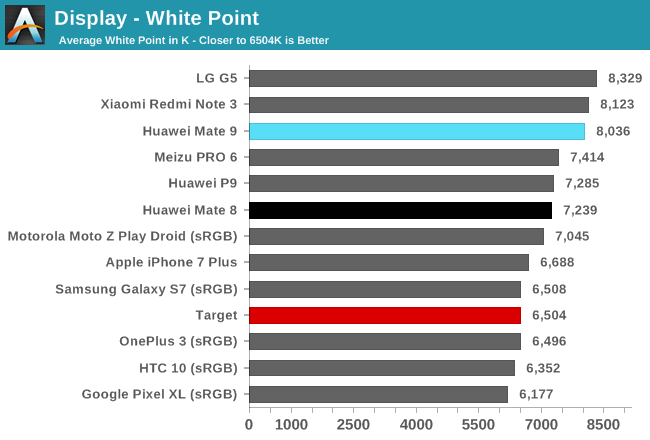
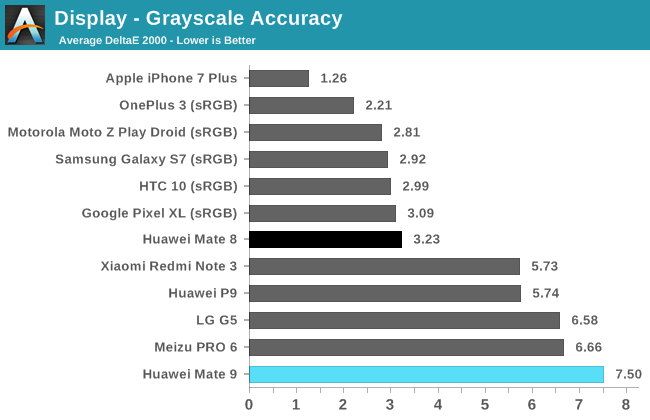
Our grayscale testing shows how Huawei continues to struggle with display calibration. At its “Default” setting, the Mate 9’s white point is over 8,000K, which is even cooler than the Mate 8 and P9. There’s too much emphasis on the blue and green primaries and not enough red, leading to rather poor grayscale accuracy—its ΔE2000 grayscale error is greater than 10 between 75%-100% luminance. This produces a noticeable aqua tint when looking at a white screen.
The Mate 9, like other Huawei phones, offers “Cold” and “Warm” color temperature modes as well as the ability to select a custom white point target by dragging a finger around a color wheel. The Cold setting moves the white point even further from the D65 target value. Increasing the imbalance between blue and red, while reducing the green primary slightly, shifts the hue of the display’s tint from aqua to blue. The name of the Mate 9’s Warm mode is misleading: There’s still too much green and not enough red, giving the screen a mint green tint.
It’s nice that Huawei includes the ability to set a custom white point; however, despite my best efforts, I was unable to get the average CCT to drop below 7,500K or completely correct the RGB imbalance that gives the screen a blue/turquoise/green tint. The best I could do was balance blue and green, while giving a small boost to red, which reduced grayscale error somewhat and made the aqua tint much less noticeable.
Huawei also missed the mark when calibrating the Mate 9’s gamma curve. In general, gamma is a bit too high, leading to a loss of shadow detail and slightly darker images. The gamma curve is not stable over the full luminance sweep either.

Huawei continues to use wide color gamut displays for its flagship phones. The Mate 9’s display extends coverage for reds and greens but the blue primary falls short relative to the sRGB gamut. Android’s lack of color management usually leads to oversaturated colors on wide gamut panels, and the Mate 9 does exhibit this characteristic for most hues once they reach the 50%-60% saturation level; however, the effect is less pronounced at lower saturation levels, where we see greater accuracy. Changing between the different display modes shifts color hues due to changes in white point but does not significantly alter saturation levels. While the Mate 9 does not have an sRGB mode to improve saturation or color accuracy, it manages to have vibrant colors without being overly garish like some wide gamut panels.
To see how the Mate 9 achieves its wider color gamut, I measured the spectral power distribution (SPD) of its backlight with a spectrometer and compared it to the LG G3, which shows the typical signature for a panel that covers around 100% of the sRGB color space. The G3’s sharp peak around 450nm comes from using blue LEDs, while broader, smaller peaks in the green and orange portions of the spectrum are from yellow photoreactive phosphors applied to the LEDs. The wavelengths of light emitted by the backlight combine into what we perceive as white light.
The Mate 9’s SPD shows a sharp peak at 455nm, indicating that it also uses blue LEDs; however, the response in the green and red portions of the spectrum look significantly different. The greater output in these colors, which give the Mate 9 its wider gamut coverage, comes from using red and green phosphors instead of a single yellow phosphor.

Color accuracy in Default mode is better than expected considering the poor grayscale performance and wide gamut display. The Mate 9’s average ΔE2000 error is not great, but most of the tested colors actually fall below 3, the threshold where error is generally considered acceptable. Using the custom setting, whose better RGB balance reduces the error component due to hue shift, drops color error further, with only highly saturated colors showing significant error.
Neither of the two Mate 9’s in our lab show any backlight bleed or issues with luminance uniformity; however, the Mate 9 suffers from the same off-axis viewing issues as the Honor 8. There’s a noticeable white, red-tinted glow that’s plainly visible at angles greater than about 10°-15° that becomes progressively worse at higher angles, eventually washing out blacks completely around 45°. There’s also a series of concentric, rainbow-colored ovals that show up when viewing the screen off-center, which are most visible on a white background, a likely byproduct of stressed birefringence in the cover glass. These rainbows are even more pronounced when viewed through polarized sunglasses. Because you’ll likely be looking at the screen straight on most of the time, these problems are not dealbreakers, but other IPS displays, like those used in the iPhones and other flagships, do not have these issues.
Display performance continues to be an issue with Huawei’s flagship phones. The Mate 9’s display in particular gets very bright and has excellent black levels for an IPS panel. But Huawei’s poor calibration degrades grayscale and color accuracy, and the preconfigured Cold and Warm white point settings only make things worse. Manually setting the white point produces better results, but the Mate 9 still cannot match the accuracy and viewing angles of its peers.


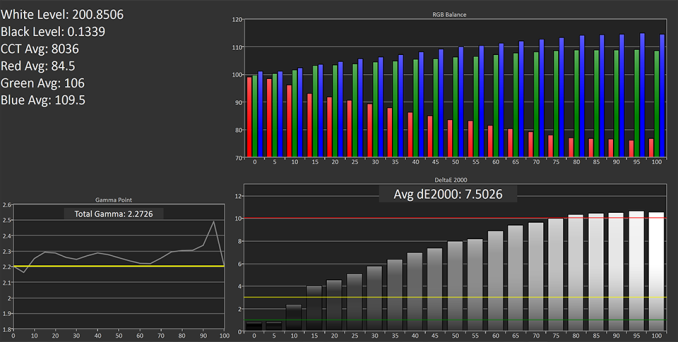

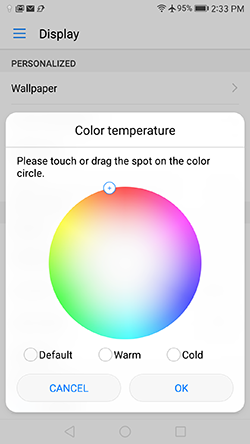

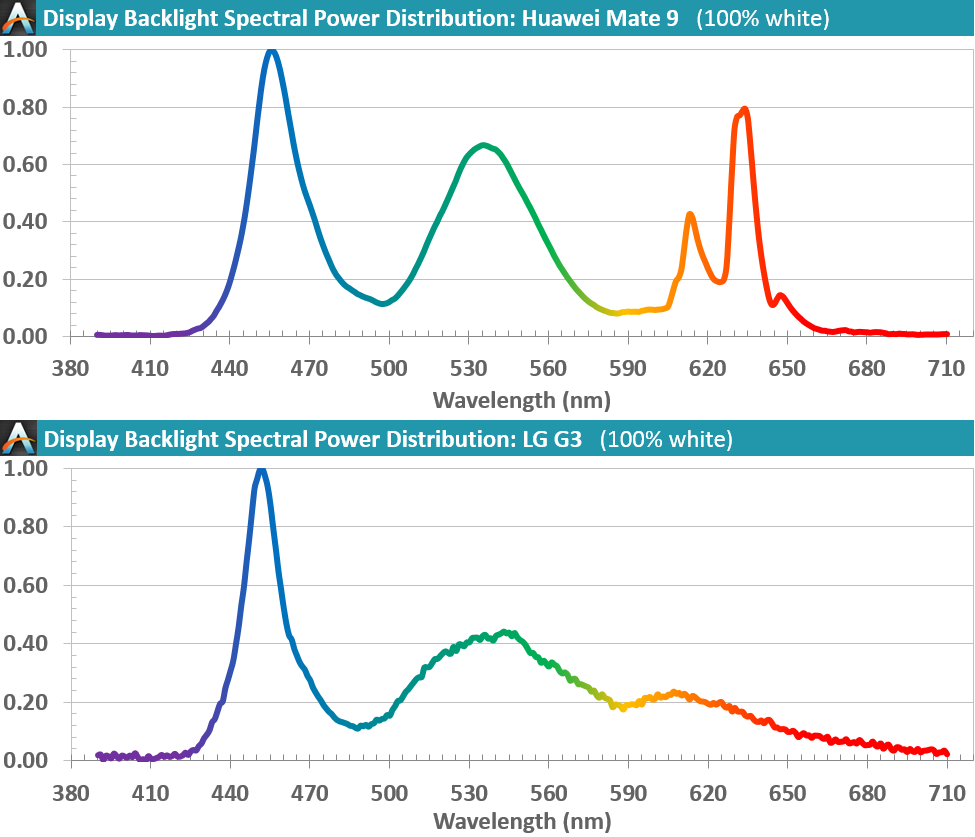










84 Comments
View All Comments
Matt Humrick - Friday, January 27, 2017 - link
This is why I like to see OEMs include multiple screen modes or other methods to adjust display parameters, and why I take the time to test and show the results for them in my reviews.Ethos Evoss - Thursday, February 23, 2017 - link
really only shame is huawei not bothering optimising video recording .. compare to galaxy 6 or 7 crapstuttering when moving from right to left ... on old iphone 6 and old galaxy s6 video recording at 1080p60 is simply the best ..
beepboopbop - Friday, January 27, 2017 - link
The biggest benefit I see from a perfectly calibrated display is that you'll be seeing media as it was meant to be seen.mrvco - Friday, January 27, 2017 - link
What media is "meant" to be seen on a tiny mobile phone screen?akdj - Tuesday, January 31, 2017 - link
Maybe the picture you take or video you attempt to capture... and 'edit' - possibly the movie you watch (5.9" after all! With speakers to boot) or the photos you view, games you play, video calls you make, there's even apps that will allow for capturing colors for Adobe profiles (for creatives) -- More and more folks' phones have become significantly more, for many... it's their primary computerAnd IMHO, with so many OEMs delivering accurate displays today, crappy ones tend to stand out and make it nearly impossible to use that phenomenal camera to it's full potential
Nitemare3219 - Friday, January 27, 2017 - link
The "average consumer" isn't checking Anandtech for reviews. I truly appreciate the color accuracy testing. Having at least a SOMEWHAT color accurate display is appreciable, once you actually use one. Some devices have colors that are way, way off and things just look ridiculous.BrokenCrayons - Friday, January 27, 2017 - link
One of the things Anandtech does in reviews that's different from most other tech sites is in-depth display analysis of all the deivces (those with displays anyhow) that they handle. Although someone like me that uses a computer to write books and fetch e-mail isn't concerned about such things, I think a pretty big percentage of AT's readers care quite a bit. Plus, putting attention on display quality may encourage device manufacturers to focus more on that sort of thing over time.If it's not important to you, just skip those portions of the review. That's what I usually do with screen testing portions.
GC2:CS - Friday, January 27, 2017 - link
I think the number one most underrated feature on display is AR coating.For me iPhone 7 - higher brightness OK, better efficiency - superb, more saturation - great.
But a AR coating even on the level 2014 iPad Air 2 would enhance all those measures much further.
It should be noted more by the reviewers.
Meteor2 - Friday, January 27, 2017 - link
This is true. The anti-reflective coating makes a bigger difference to usability outdoors than screen brightness. The iPad Air 2 and Pro really excel there.lopri - Friday, January 27, 2017 - link
There is not much else to talk about this phone's display. This is a plain old LCD with inaccurate colors. All other LCD shortcomings apply as well. High brightness is nice but that cannot replace the versatility of high contrast (e.g. AMOLED).